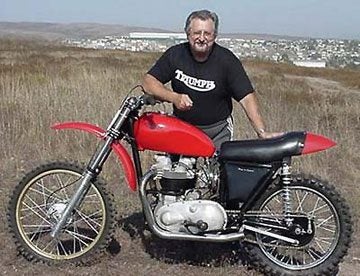 Don’t Ask!
Don’t Ask!
Go ahead, but if your question is stupid, you’ve been warned…
If you choose to email a question to this forum, then you must conduct yourself accordingly. Therefore, the following rules are in order:
1. Do not write your email to me IN CAPS. If you do so, I will print out your question and do terrible things to it.
2. Do not request a personal e-mail response. Since I get thousands of questions each month, trying to answer them all would cut deeply into my leisure time, which I value more than your current state of confusion.
3. Try to spell at least in a semi-correct fashion. If you choose to mangle the English language, expect no mercy from this quarter. You might be mocked severely.
4. Do not ask for me to send you copies of my many manuals and literature. I am not in the library business, nor do I want to spend the bulk of my day at the copy machine just because you’re too lazy to ask your dealer, or look around a bit.
5. Don’t bother me with truly stupid questions, like how to get 50 more horsepower for a buck and a half
6. Now that you know the rules, think carefully and have at it!
Oh yes … I’ll leave your e-mail unedited, for what it’s worth.
Send your questions to editor@dirtbikes.com, Attn: Don’t Ask, or leave your questions in the comment section below.
***
SUBJECT: MAICO PORTING SPECS
Rick,
Would you know if dirt bike ever covered recommended power updates like porting for a 1971 250. I have a stock square barrel and would like to see what was recommended by Maico for a faster bike for motocross use.
Thanks,
Robert Doran
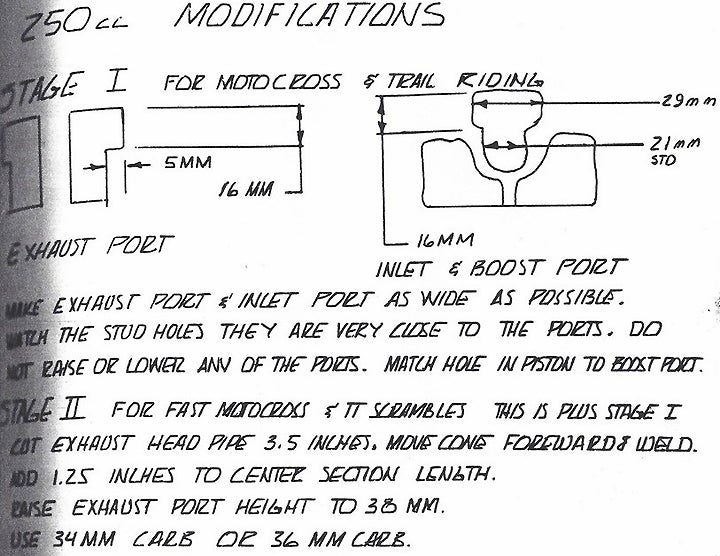
I found a page that gives you the answers to your question. Sorry it’s in the form that it is, but that’s all we’ve got. Hope this helps.
***
SUBJECT: 501 MAICO PORTING/MOD SPECS
I love the article “In defense of the 501 Maico”. I have a couple that I will be restoring over the next several years. I was wondering if you would have or know where I could get the porting and jetting specs that are mentioned in the article. Any help would be greatly appreciated.
Thank you,
Dave Andrasik
Here’s what works on the 501: Cut 3 inches out of first cone of the exhaust pipe. Then raise the exhaust port one millimeter. Also try a 2mm larger carb. That should do it.
***
SUBJECT: NAME THAT VINTAGE DIRT BIKE SILENCER?
Greetings Super Hunky,
Came across this ad in Craiglist San Diego for a sale of Vintage Bikes. Attached is an image of a Suzuki TM 400 with a round silencer on the pipe. I remember seeing one before but can’t recall who made it and what it was called?
Some neat old bikes, some I have never seen before. If you would like to check it out, the link is as follows -https://sandiego.craigslist.org/nsd/mcy/5815926470.html
Be safe and strong,
Big Pat {AKA ESP}
El Cajon, CA

Looks like a banjo!! Xduser from Supertrapp.
***
SUBJECT: FUTURE RIDE
Dear Mr. Sieman,
Decades ago you wrote a prescient science fiction store about a guy that takes a government sanctioned, controlled and managed motorcycle ride, but goes off the reservation — with the logical and tragic conclusion. In the telling was a lot of detailed satire that I recall finding humorous but I’m sure if I could find the article again even more of it would have come to pass. I had a mountain of Dirt Bike, Off Road, and Modern Cycle magazines that got wrecked in a basement flood in Sewickley PA (also decades ago) and wonder if you’d know the magazine and issue or any other source of this great tale?
Happy Trails,
Will
FUTURE RIDE
By Rick Sieman/April 1979/Dirt Bike
(Notes: I’ve always been a big science fiction fan. (Favorite writer? Jack Vance) So, after reading a particularly good Vance book, I figured I’d try to write a sci-fi piece for my column. When this column hit the stands, the mail from the readers was staggering! Even now, as I prepped this prophetic story for inclusion, it sent a small chill up my spine. For the life of me, I can’t recall where the idea came from. But the concept is far too real to ignore.)
“Tell us about the way it used to be, Grandpa?”
“Oh, I don’t know. It’s getting sort of late. You three should be in bed by this time.”
“Oh, please! Please! There’s no school tomorrow. We can do our homework after the State Clinic in the afternoon. Please?”
“Well, OK. But just a small story. After all, you’ve heard it time after time.”
“But Ginny never heard it … and she’s our new home sister for this year.”
They all sat down on the floor in a rough circle around the old man; the two regular children on the left and the newly assigned child on the right. The old man received 400 credits a month for taking care of these children, so he thought he might as well make them happy while they were under his wing.
The years had not been easy on the old man. One eye was glazed white and unseeing. A long scar coursed from his forehead to his chin. His hair was white and thinning. His hands were gnarled and the skin on the calloused areas was thick and cracked deeply. It was more than obvious that many years had been spent under body-breaking labor of some sort.
He cleared his throat, leaned back and closed his eyes. He folded his cracked, weather-beaten hands over his coarse shirt front, knotted his brows for a moment, then began to speak: “It used to be that there was so much land, that a man could walk for miles. You could get up on top of a hill, and as far as you could look, it’d be all open land.
“I used to live out in New Los Angeles … about 100 miles north of the old city that got burnt in the War of ‘92. It was actually situated in the heart of the great Mojave Desert. God, you should have seen that place! Miles of sand and rocks. As far as you could see.
“We city folks used to take the conveyor belt out to the edge of town and walk around out there and just look. Sometimes, we’d even take some food pellets along and spend a whole recreation period … just walkin’ around and looking.
“Then one day, when I graduated from Social Placement II — I had just turned 17 — I got a whole two weeks of free time. Well, free time was no easy thing to come by, so I figured I’d better spend it wisely. Back then, a man got three vacation periods in his span. Not like now. Now, you only get two.
“I thought about going to the State Beach Hostel and lying in the sun. Then I thought about the free two-week State Drug Clinic. Then, I thought about my old crazy Uncle Joe.
“My Mom had told me about Uncle Joe, but I’d only seen him once when I was a kid. He came out from his place in the desert to visit us. Only stayed a few days, then took off. Well, I beamed Uncle Joe and asked him if I could come and see him. He said OK, as long as I brought some booze. He sure was a drinker, that crazy Uncle Joe.
“Anyways, I took the belt to the edge of New L.A., then thumbed a ride on the tube heading straight out across the desert toward Salt Lake. I got off at the Barstow Substation, wondering just how I was going to get back to Uncle Joe’s place. My Mom told me it was way back from the main tube and only wild animals and crazy hermits lived there.
“Boy, I sure was surprised when I walked out of the tunnel, and there, sitting in the sunlight, was crazy Uncle Joe … on a motorcycle! Now, I’d seen a few motorcycles before, but only the Army and the Police rode them. And you sure didn’t want to get anywhere near those guys. You see, private ownership of motorcycles was outlawed in ‘98. Cars and such weren’t banned until the turn of the century in ‘26 or ‘27. I can’t remember which year. It isn’t important, though, is it?
“I knew Uncle Joe wasn’t a cop, or in the Army, so I couldn’t figure out how he could ride one of those motorcycles around. He recognized me right away and waved me over to the bike. I stood there like an idiot, with my jaw swinging. He shook my hand and told me to get on the back.
“I was stunned!! Me, not even 18 years old and I was going to commit a federal offense! You could get six years in Rehabilitation for riding in a car without a permit. God knows what the penalty would be on a motorcycle! Still, I cautiously approached the machine and placed my foot where Uncle Joe told me to. Then, placing my weight on the peg, I swung my leg over the saddle and sat down. A chill ran through me!
“Uncle Joe then flipped out a lever of sorts, placed his heavy boot on it, and kicked down swiftly. The engine ripped to life and scared me real bad, kids. Oh, I’d heard engines before, but it’s all different when one is nestled right between your legs.
“Before I knew what was happening, the motorcycle was moving! And I was on it! Children, you have no idea what it feels like to actually ride on one of those machines. We headed out of the parking area and onto a dirt road. The first time Uncle Joe tried to lean it over, I flailed my arms out to try and straighten us up. The whole works — me and Uncle Joe — we wobbled all over the dirt road. Uncle Joe warned me not to do that again. Just follow him, he said. Lean when he leaned. Trusting Uncle Joe for some unknown reason, I did as he said, and soon I learned to become as one with the motorcycle.
“As turns and corners came up, Uncle Joe would lean the machine over and roll the throttle on. The engine would hum and the combination of two humans and one machine would glide through, as if the laws of gravity and nature were momentarily suspended.
“The road back to Uncle Joe’s place was only about 30 miles long, as I learned later, but that first ride on the motorcycle seemed to last forever. I can still remember every foot of that ride to this very day.
“When we got to Uncle Joe’s place, we rested awhile and had some of the booze I had brought. Then, he showed me around. It wasn’t much. The house was small, made mostly of plasti¬-brick and corrugated tin roofing. You could see sunlight here and there through the roof.
“Out back was a large shed, made from, of all things — actual wood! I wondered how he managed to get hold of real wood in that day and age, and he laughed and told me it was just lying around if you knew where to look for it.
“When he opened the shed, I received yet another shock. There, in the shed, were a car, a truck and three motorcycles. Too stunned for words, I merely followed Uncle Joe around as he explained what they were. The car, he said, was a Chevrolet. One of the last rotary diesels of the pre-’92 war. The truck was a solar-powered unit from‘02.
“The bikes were early ‘80 models. According to Uncle Joe, anything after the early ‘80 models was just junk and hardly worth riding. The red one was a Yamaha YZ250L, said Uncle Joe. It was the last of the true racers, he said.
“The yellow one was a Tai’ke 175. Uncle Joe said that it was one of the last trailbikes made in New China … and a good all-around bike. The last one really caught my eye. It was a Banetta 400 racer from the Republic of Argentina, one of the great industrial powers right before the big war. It was beautiful … at least to a 17-year-old impressionable boy. It sat there, sleek and arrogant-looking, with only a light layer of dust covering the silver-gray paint job.
“I never asked Uncle Joe how he got all these bikes. I didn’t want to know. All I wanted to do was ride that gray Banetta just one time. Just to see what it felt like.
“I asked Uncle Joe. He suggested that I try one of the others, as the 400 Banetta might be too much for me. But, when he saw the disappointment in my eyes, he told me that tomorrow, after breakfast, he would teach me how to ride the machine.
“I couldn’t sleep that night! I had visions of leaning into turns just like Uncle Joe. All by myself! Somehow, someway, the long night ended. I bolted my food pellets down quickly, while Uncle Joe just nibbled at his and sipped what was left of the booze I had brought.
“It was time. Uncle Joe rolled two of the bikes out of the shed and fired up the Yamaha. He told me to watch what he did. He explained patiently how the controls worked, how to stand on the pegs, how to shift and stop and what to do if anything went wrong.
“He slipped a battered old white helmet on my head, snapped it in snug, and let me start the bike. The feeling of straddling over a living mechanical device sent shakes through my body. My hands trembled. The heart pounded. I engaged a gear and rolled the throttle on. The machine lurched forward, startling me, but it was moving.
“I spent the next ten minutes getting the feel of the Banetta. The soft sand wasn’t too deep and kept me from making mistakes on more than one occasion. Uncle Joe was right about one thing: The 400 Banetta was far too much of a machine for learning on. More than once, I gave it too much throttle and the bike would snap suddenly upright.
“Uncle Joe waved me to a halt and I stalled the Banetta right in front of him. My hands were shaking like a leaf and my temples were pounding with excitement. I was hooked.
“Over the next two weeks, I spent every possible hour I could riding the Banetta. I tried the other bikes, and while they were pleasant, the 400 was the one for me. On the fourth day, Uncle Joe decided that I was ready for a “trail ride,” whatever that was.
“He fired up the Yamaha and told me to follow him out into the desert. I followed as if in a trance. We rode for hours, came back and gassed up, then rode for more hours.
“I saw things I never even knew existed. Vast rolling sand dunes. Narrow canyons laced with rocks. Huge open areas with brush spotting the landscape. I rode to the tops of huge mountains and looked out over the rolling land like a deity.
“For the first time in my life, I lived. Far too quickly, the two weeks were over. I knew I had to go back and take a job that some impersonal computer would spit out for me. Who knows where I’d live?
“I didn’t tell Uncle Joe when my two weeks were up. The time was too precious to me. In the day, we’d ride the bikes. In the evening, we’d work on them. I learned to clean a filter. How to use tools. How to understand the electrical system. How to shape things up before they’d break. I loved it. I didn’t want it to end.
“After a month went by, I had to leave. I was already in trouble. More time would make it worse for me. I hugged my crazy Uncle Joe and waved good-bye to him at the tube ramp pickup station.
“When I got back to my cubicle, they were waiting for me. The State Police, that is. I got four years in the quarry. That’s how I lost this eye here. A guard with a laser.
“Anyhow, when I got out, I went back to work for some time in my old district and tried to forget about the past. Then, one day, I got word that my crazy Uncle Joe had died and left me all of his belongings in his will.
“I got back on the belt and headed for Barstow. A State Truck dropped me off at Uncle Joe’s place after I bribed the driver.
“Everything was there, just like the day I left it. The Banetta had a heavy layer of dust on it. It took two days of work to get it running right. Then, I went out into the desert and rode. And rode. And rode.
“Everything would have probably been OK if I hadn’t tried to take that gas from that Army truck. They caught me. Twenty-two years, the judge told me. Theft of government property. Riding on public land. Riding in or on a vehicle without a permit. Private possession of a motor vehicle. They got me good.
“After I got out, they reprogrammed my mind and made me a worthwhile citizen. Now I’m serving society by taking care of you nice people. I sort of like it. Kids are nice to be around.”
At this point, there was a knock on the door. The oldest child, Ann, opened it. Three State Policemen walked in, with the swagger that only exists in absolute authority.
“Old man,” they said, “we’ve been taping the trash you’ve been feeding to these children in your care. Come with us. Now.”
The old man got up, put on a gray coat and hugged each one of the children good-bye. A State Policeman got on each side of the old man and escorted him out of the door.
The children looked at each other. Ann, the eldest, turned and said, “No matter what, I liked his stories. Do you really think it was that way, or was he making it up?”
Mister “Super Hunky” Sieman,
Thank you so much! I am honestly gobsmacked and thrilled to get email from Rick Sieman; you’re an Icon, one of my heroes as a kid, and surrogate dad! I can’t believe you took the time to write — and what a great story! Wasn’t the one I was looking for, but I remember this one too and love it!
In the story I was recollecting you told a tale of a ‘future’ motorcycle ride, on some sort of a of enormously heavy bike tethered merry-go-round ride on a virtual track — in it our Adventurer/Hero decides to go off the reservation with the bike and gets his head blown off by the loving and compassionate government.
Ours is not the world I imagined I’d be growing old in; I always had sense of optimism that while I thought there’d always be a fair amount of the insanity; you seem to have anticipated a lot more of it then I would have believed. I always took your humorous anecdotes, sarcasm and satire as a fun and stern warning ‘better not let this happen kids’ sort of thing — now far too much of it has come to pass and your stories like the movie Network are disturbing in how prescient they are.
Miss Ya & Your Writing,
Sincerely,
Will
***
SUBJECT: SPECIAL PIPE FOR 360 YAMAHA ENDURO
Hi,
Hope I have the right e-mail. Checking to see if anyone make a low pipe for a Yamaha 360 enduro? Please reply to this e-mail.
Thanks,
John
We contacted Keith Lynas on this one. Here’s what he had to say:
Hi Rick,
I have a guy that can make one but he is super busy and has a backlog…I would guess 3-4 months for delivery…approx.
I will check around but not many people build old stuff, or know how.
thanks,
Keith
KLynas@aol.com
***
SUBJECT: 1976 KX250
Hi Rick,
I came across your site and was wondering if you can help me out. I came across a 1976 Kaw KX250. It’s all original and near excellent condition. Only about 100 miles on it. Was wondering your thoughts on it. Any expertise info would be highly appreciated I’m thinking about buying it. Attached are 2 shots of it. Thanks for your time.
Bob
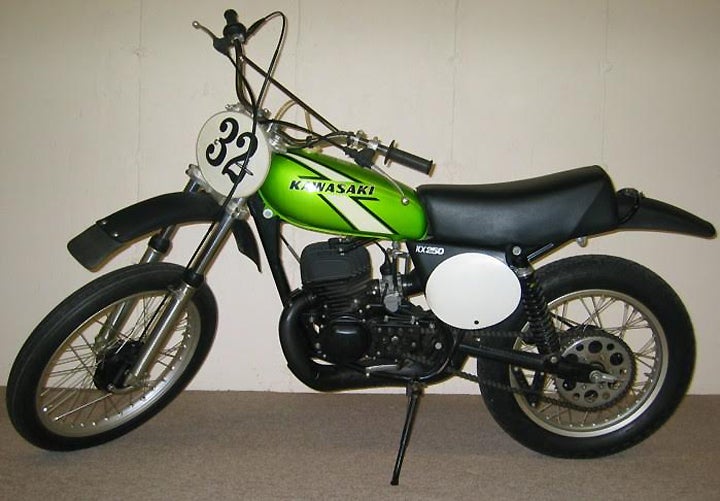
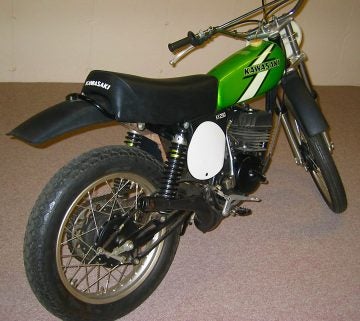 The 76 piston port KX250 was the last year of the down pipe. The engine put out 34hp at 8000 rpm and [the bike] weighed 219 pound,s and the 249cc air-cooled engine had a broad powerband. The KX250 was produced from 1974 to 1976 with little change other than color and graphics. The bike was competitive power-wise, but the suspension was rated at average. If the bike is in the shape you say it is, grab it if the price is right.
The 76 piston port KX250 was the last year of the down pipe. The engine put out 34hp at 8000 rpm and [the bike] weighed 219 pound,s and the 249cc air-cooled engine had a broad powerband. The KX250 was produced from 1974 to 1976 with little change other than color and graphics. The bike was competitive power-wise, but the suspension was rated at average. If the bike is in the shape you say it is, grab it if the price is right.
***
***
***
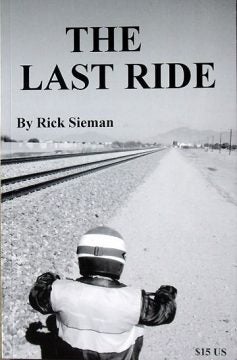 My new book, THE LAST RIDE, is at now out. It’s fiction and starts in 1969, when an 18-year-old kid just out of high school gets a chance to ride his Yamaha 250 DT1 from Pennsylvania to Los Angeles … all off-road. His adventures are truly amazing. The book then jumps 40+ years where the same person, now in his 60s, wants to get that old Yamaha back in his possession and return it home by riding it all off-road across the country again. The book is $15 plus $2.75 for mail anywhere in the US and for more information, the email is: superhunky@gmail.com.
My new book, THE LAST RIDE, is at now out. It’s fiction and starts in 1969, when an 18-year-old kid just out of high school gets a chance to ride his Yamaha 250 DT1 from Pennsylvania to Los Angeles … all off-road. His adventures are truly amazing. The book then jumps 40+ years where the same person, now in his 60s, wants to get that old Yamaha back in his possession and return it home by riding it all off-road across the country again. The book is $15 plus $2.75 for mail anywhere in the US and for more information, the email is: superhunky@gmail.com.
Paypal address: superhunky@gmail.com
 Your Privacy Choices
Your Privacy Choices